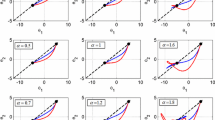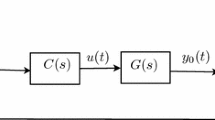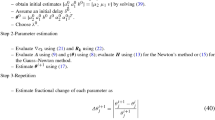Abstract
The fractional-order derivative is a powerful and promising concept to describe many physical phenomena due to its heredity/memory feature. This paper aims to establish a general methodology for parameter identification of nonlinear fractional-order systems based on the time domain response data and the sensitivity analysis. The development of the enhanced response sensitivity approach is mainly threefold. Firstly, a computational scheme based on the Adams-type discretization and the Newmark-\(\beta \) method is presented to get the numerical solution of the nonlinear fractional-order systems. Thereafter, a hybrid strategy is developed to proceed the sensitivity analysis where the sensitivity to the fractional-order parameters is obtained through finite different calculation, while the sensitivity to other parameters is analyzed via direct differentiation. Secondly, the trust-region constraint is incorporated into the response sensitivity approach, and as a result, a weak convergence is reached. Thirdly, the optimal choice of the weight matrix within the framework of the response sensitivity approach is derived by minimizing the identification error, and eventually, the reciprocal of the measurement error covariance is found to be the optimal weight matrix. Numerical examples are conducted to testify the feasibility and efficiency of the present approach for parameter identification of nonlinear fractional-order systems and to verify the improvement in the identification accuracy brought up by the optimal weight matrix.











Similar content being viewed by others
References
Machado, J.T., Galhano, A.M., Trujillo, J.J.: On development of fractional calculus during the last fifty years. Scientometrics 98(1), 577–582 (2014)
Cuadrado-Laborde, C., Poveda-Wong, L., et al.: Analogous photonic fractional signal processing. Prog. Opt. 63, 93–178 (2018)
Liu, L., Zheng, L., Zhang, X.: Fractional anomalous diffusion with Cattaneo–Christov flux effects in a comb-like structure. Appl. Math. Model. 40(13–14), 6663–6675 (2016)
Muller, S., Kastner, M., Brummund, J., et al.: On the numerical handling of fractional viscoelastic material models in a FE analysis. Comput. Mech. 51(6), 999–1012 (2013)
Ichise, M., Nagayanagi, Y., Kojima, T.: An analog simulation of non-integer order transfer functions for analysis of electrode processes. J. Electroanal. Chem. Interfacial Electrochem. 33(2), 253–265 (1971)
Yuan, L., Agrawal, O.P.: A numerical scheme for dynamic systems containing fractional derivatives. J. Vib. Acoust. 124(2), 321–324 (2002)
Laskin, N.: Fractional market dynamics. Physica A 287(3), 482–492 (2000)
Zhang, K., Li, D.: Electromagnetic Theory for Microwaves and Optoelectronics. Springer, New York (2013)
Dizqah, A.M., Maheri, A., Busawon, K.: An accurate method for the PV model identification based on a genetic algorithm and the interior-point method. Renew. Energy 72(2), 212–222 (2014)
Arikoglu, A.: A new fractional order derivative model for linearly viscoelastic materials and parameter identification via genetic algorithms. Rheol. Acta 53(3), 219–233 (2014)
Wei, H., Yu, Y., Gu, W.: Parameter estimation of fractional-order arbitrary dimensional hyperchaotic systems via a hybrid adaptive artifical bee colony algorithm with simulated annealing algorithm. Eng. Appl. Artif. Intell. 68, 172–191 (2018)
Lin, J., Wang, Z.J.: Parameter identification for fractional-order chaotic systems using a hybrid stochastic fractal search algorithm. Nonlinear Dyn. 90, 1243–1255 (2017)
Yuan, L.G., Yang, Q.C.: Parameter identification and synchronization of fractional-order chaotic systems. Commun. Nonlinear Sci. Numer. Simul. 17, 305–316 (2012)
Poinot, T., Trigeassou, J.C.: Identification of fractional systems using an output-error technique. Nonlinear Dyn. 38, 133–154 (2004)
Leyden, K., Goodwine, B. (2018) Fractional-order system identification for health monitoring. Nonlinear Dyn. https://doi.org/10.1007/s11071-018-4128-y
More, J.J.: The Levenberg–Marquardt algorithm: implementation and theory. Chapter numerical analysis, volume 630 of the Series. In: Watson, G.A. (ed.) Lecture Notes in Mathematics, pp. 105–116. Springer, Berlin (1978)
Mani, A.K., Narayanan, M.D., Sen, M.: Parameter identification of fractional-order nonlinear systems. Nonlinear Dyn. (2018). https://doi.org/10.1007/s11071-018-4238-6
Lu, Z.R., Law, S.S.: Features of dynamic response sensitivity and its application in damage detection. J. Sound Vib. 303, 305–329 (2007)
Lu, Z.R., Wang, L.: An enhanced response sensitivity approach for structural damage identification: convergence and performance. Int. J. Numer. Methods Eng. 111, 1231–1251 (2017)
Wang, L., Liu, J., Lu, Z.R.: Incremental response sensitivity approach for parameter identification of chaotic and hyperchaotic systems. Nonlinear Dyn. 89, 153–167 (2017)
Lu, Z.R., Yao, R., Wang, L., Liu, J.K.: Identification of nonlinear hysteretic parameters by enhanced response sensitivity approach. Int. J. Non Linear Mech. 96, 1–11 (2017)
Bakir, P.G., Reynders, E., De Roeck, G.: Sensitivity-based finite element model updating using constrained optimization with a trust region algorithm. J. Sound Vib. 305, 211–225 (2007)
Hansen, P.C.: Analysis of discrete ill-posed problems by means of the L-curves. SIAM Rev. 34(4), 561–580 (1992)
Hansen, P.C.: Regularization tools—a matlab package for analysis and solution of discrete ill-posed problem. Numer. Algorithms 6(1), 1–35 (1994)
Brownlee, K.A.: Statistical Theory and Methodology in Science and Engineering. Wiley, Hoboken (1965)
Acknowledgements
The present investigation was performed under the support of National Natural Science Foundation of China (Nos. 11572356 and 11702336), Guangdong Province Natural Science Foundation (No. 2017A030313007), Guangdong Province Science and Technology Program (No. 2016A020223006) and the Fundamental Research Funds of the Central Universities (Nos. 17lgjc42 and 17lgpy54).
Author information
Authors and Affiliations
Corresponding author
Ethics declarations
Conflict of interest
The authors declare that they have no conflict of interest.
Rights and permissions
About this article
Cite this article
Lu, ZR., Liu, G., Liu, J. et al. Parameter identification of nonlinear fractional-order systems by enhanced response sensitivity approach. Nonlinear Dyn 95, 1495–1512 (2019). https://doi.org/10.1007/s11071-018-4640-0
Received:
Accepted:
Published:
Issue Date:
DOI: https://doi.org/10.1007/s11071-018-4640-0




